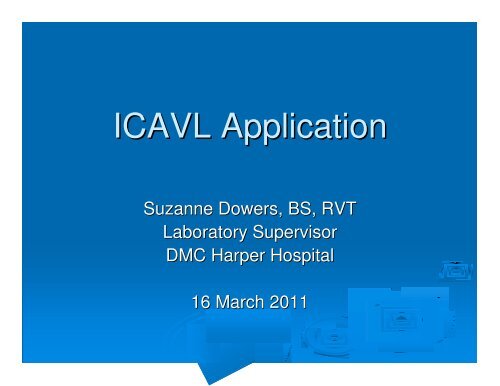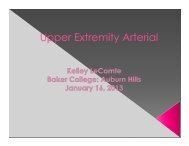ICAVL Application - Michigan Vascular Association
ICAVL Application - Michigan Vascular Association
ICAVL Application - Michigan Vascular Association
You also want an ePaper? Increase the reach of your titles
YUMPU automatically turns print PDFs into web optimized ePapers that Google loves.
<strong>ICAVL</strong> <strong>Application</strong><br />
Suzanne Dowers, BS, RVT<br />
Laboratory Supervisor<br />
DMC Harper Hospital<br />
16 March 2011
Preparing Your <strong>Application</strong><br />
How To Prepare<br />
<br />
<br />
<br />
Case Studies and Send a Submission<br />
IAC Agreement<br />
Attachments<br />
Helpful Resources<br />
<br />
<br />
<br />
<br />
Sample Documents<br />
CME Resources<br />
Links & References & Webcasts<br />
IAC Newsletter
How to Prepare - Case Studies<br />
<br />
<br />
<br />
Case study submissions are required in order to assess the<br />
interpretative and technical quality of the laboratory. All of<br />
the details of the vascular anatomy should be visualized<br />
adequately.<br />
Please note:<br />
<br />
<br />
All cases must be selected from within the past 12 months<br />
from the date of application filing.<br />
Remember to submit the entire application, including case<br />
studies, in duplicate.<br />
Case study requirements have been grouped into the<br />
following categories:<br />
<br />
<br />
<br />
<br />
<br />
EXTRACRANIAL CEREBROVASCULAR,<br />
INTRACRANIAL CEREBROVASCULAR,<br />
PERIPHERAL ARTERIAL,<br />
PERIPHERAL VENOUS,<br />
VISCERAL VASCULAR and SCREENING
How to Send a Submission<br />
<br />
<br />
<br />
<br />
Please note: Laboratories are required to send printed or<br />
electronic final reports.<br />
<br />
<br />
Submit all images utilized in the interpretation of a study by a physician.<br />
Use sample cases from as many medical and technical staff members that<br />
interpret or perform the vascular examinations in the laboratory as<br />
possible.<br />
Two reviewers evaluate every application; therefore it is<br />
imperative that all case study materials submitted to the <strong>ICAVL</strong><br />
be sent in duplicate.<br />
<br />
<br />
If you are unable to submit digital images, high quality black-and-white and<br />
color copies of processed images may be submitted on paper.<br />
Cases are to be performed with current personnel on current equipment.<br />
Labeling Your Submission<br />
Label all cases (an adhesive label affixed to each page is<br />
recommended), including any disks or hard copies, with:<br />
<br />
<br />
<br />
<br />
Laboratory name/ID number/site location<br />
Patient name<br />
Date of study<br />
Type of study
How to Prepare – IAC Agreement<br />
A completed IAC Accreditation Agreement<br />
(current published version is 7/2010) in order<br />
to receive an accreditation decision.<br />
Download the IAC Agreement<br />
<br />
To download the IAC Agreement and get complete<br />
instructions, visit the Legal>Agreement section of the IAC<br />
website»<br />
Download the IAC Policies and Procedures<br />
<br />
To download the IAC Policies and Procedures and get<br />
complete instructions, visit the Legal>Policies & Procedures<br />
section of the IAC website»
How to Prepare - Attachments<br />
<br />
<br />
<br />
<br />
Applicant laboratories are required to upload and<br />
submit all attachments electronically.<br />
<br />
Case study materials [i.e., reports, hard copy and CDs]<br />
must still be shipped to the <strong>ICAVL</strong> office, in duplicate.<br />
Uploading of electronic or scanned documents Is an<br />
easy process.<br />
<br />
<br />
Upon being prompted within the application questionnaire<br />
for a specific document, the user clicks “browse," selects<br />
the appropriate document from their computer or<br />
memory/storage device and then clicks “open.<br />
The document is uploaded to the correct location within<br />
the application and then saved once the user navigates<br />
away from that page by clicking the “previous,” “next” or<br />
“end” button at the bottom of the screen.<br />
Only the file types in the box listed to the right may be<br />
used when uploading attachments to the application<br />
questions.<br />
The file size for each document must be less that 4 MB.<br />
This includes .zip/compressed files.<br />
ACCEPTABLE<br />
FILE<br />
FORMATS<br />
.txt<br />
.doc<br />
.docx<br />
.rtf<br />
.tiff<br />
.gif<br />
.jpg<br />
.jpeg<br />
.png<br />
.pdf<br />
.xls<br />
.xlsx
Useful Resources<br />
The on line tool section<br />
is full of resources to<br />
help you through the<br />
<strong>ICAVL</strong> accreditation<br />
process, including:<br />
Sample documents<br />
Links & references<br />
CME resources<br />
On Demand webcasts<br />
IAC Newsletter<br />
VERY USEFUL<br />
Sample Forms:<br />
• Blank QA Log<br />
• Venous QA Log<br />
• Instructions for a QA Log
QA Log Instructions<br />
No.<br />
1<br />
Ident<br />
ificati<br />
on 2<br />
Side 3<br />
<strong>Vascular</strong><br />
lab study<br />
4<br />
<strong>Vascular</strong><br />
lab date 5<br />
Correl<br />
ative<br />
study 6<br />
Correl<br />
ative<br />
study<br />
date 7<br />
Vascul<br />
ar lab<br />
finding<br />
s 8<br />
Correlativ<br />
e study<br />
findings 9<br />
Match<br />
by<br />
locatio<br />
n 10<br />
Match<br />
by<br />
severit<br />
y 11<br />
Diagnostic<br />
criteria<br />
correct in<br />
report 12<br />
1<br />
2<br />
No. 1 : Each correlation gets its own line. See standards for the number of correlations needed for each type<br />
of examination.<br />
Identification 2 : Each patient should be identified. Examples: medical record number, laboratory examination<br />
number.<br />
Side 3 : Bilateral examinations should generally be two correlations (one line for each side) as long as the<br />
correlative study is also performed bilaterally. If the correlation study is performed on one side only, one<br />
correlation is recorded (for example, bilateral carotid ultrasound but a unilateral contrast angiogram is one<br />
correlation). Some examinations do not have a side (for example, hepatoportal examination).<br />
<strong>Vascular</strong> lab study 4 : Name of the vascular lab study.<br />
<strong>Vascular</strong> lab date 5 : Date of the vascular lab study.<br />
Correlative study 6 : Type of correlative study. Only one correlative study is used even if several different<br />
correlative tests have been performed. Contrast arteriography/venography is used if it is available. CT or MR<br />
is used next, followed by surgical correlation, followed by other correlations. See specific standards for<br />
acceptable correlative studies.
Laboratory Name: Harper <strong>Vascular</strong> lab<br />
Correlation for: VENOUS STUDIES<br />
#<br />
Patient<br />
Identifi<br />
cation<br />
Side<br />
QA Log – <strong>Vascular</strong><br />
<strong>Vascular</strong><br />
Lab Study Study Date Study<br />
Quality Assurance Log<br />
Correl.Study<br />
Date<br />
<strong>Vascular</strong> Lab<br />
Findings<br />
Correlative<br />
Study Findings<br />
Match by<br />
Location<br />
Match by<br />
Severity<br />
Diagnostic<br />
Criteria<br />
Correct in<br />
1 P.H. LT Ven dup 3/10/2010 Venogram 4/28/2010 DVT, CFV, FV, POP V DVT FV & POP V Yes Yes Yes<br />
2 C.J. RT Ven dup 9/14/2010 Venogram 9/16/2010 DVT, CFV, FV, POP V DVT FV extensive Yes Yes Yes<br />
3 R.B. RT Ven dup 6/18/2010 Venogram 6/20/2010 DVT, CFV DVT CFV Yes Yes Yes<br />
4 S.S. RT Ven dup 1/30/2010 Venogram 2/2/2010<br />
DVT, CFV, FV, POP V,<br />
PTV, PER V DVT CFV, FV Yes Yes Yes<br />
5 S.S. LT Ven dup 1/30/2010 Venogram 2/2/2010 DVT CFV, FV DVT CFV, FV Yes Yes Yes<br />
6 B.J. RT Ven dup 2/19/2010 Venogram 2/25/2010 DVT EIV, CFV, FV Diploid IVC filter Yes Yes Yes<br />
7 B.J. LT Ven dup 2/19/2010 Venogram 2/25/2010 DVT CFV, FV, POP V Diploid IVC Yes Yes Yes<br />
8 R.B. RT Ven dup 7/7/2010 Venogram 9/13/2010 DVT FV, CFV DVT CFV Yes Yes Yes<br />
9 R.B. LT Ven dup 7/7/2010 Venogram 9/13/2010 DVT CFV DVT CFV Yes Yes Yes<br />
10 R.A. LT Ven dup 1/4/2010 Venogram 1/5/2010 No DVT No DVT Yes Yes Yes<br />
11 H.H. LT Ven dup 3/19/2010 Venogram 4/14/2010 DVT EIV, CFV EIV Yes Yes Yes<br />
12 T.C. LT Ven dup 3/16/2010 Venogram 6/16/2010 Insuff. (fem) EIV OCC Yes Yes Yes<br />
13 D.R. RT Ven dup 7/29/2010 Venogram 8/20/2010 Insuff. Insuff. Yes Yes Yes<br />
14 S.S LT Ven dup 3/30/2010 Venogram 4/2/2010 DVT FV, POP V LT DVT CIV Yes Yes Yes<br />
15 L.S. LT Ven dup 8/31/2010 Venogram 8/31/2010 DVT, PTV, PER PE Yes Yes Yes<br />
16 J.W. RT Ven dup 8/28/2009 Venogram 8/29/2009 DVT CFV DVT CFV Yes Yes Yes<br />
17 C.D. RT Ven dup 1/21/2010 Venogram 2/23/2010 Venous stasis Venous stasis Yes Yes Yes<br />
18 H.H LT Ven dup 5/3/2010 Venogram 5/4/2010 DVT, PE DVT, PE Yes Yes Yes<br />
19 S.R RT Ven dup 2/2/2010 Venogram 3/25/2010 Chronic Chronic Yes Yes Yes<br />
20 S.R. LT Ven dup 2/2/2010 Venogram 3/25/2010 Insuff. Insuff. Yes Yes Yes<br />
21 F.S RT Ven dup 10/10/2009 Venogram 8/26/2010 Insuff. Insuff. Yes Yes Yes<br />
22 A.F. RT Ven dup 1/23/2008 Venogram 1/24/2008 DVT, CFV, FV, POP V DVT CFV & FV Yes Yes Yes<br />
23 S.M. RT Ven dup 7/14/2010 Operative 8/26/2010 2.6 sec Ablation (R GSV) Yes Yes Yes<br />
24 T.J. RT Ven dup 5/14/2010 Operative 6/30/2010 2.9 sec Ablation (R GSV) Yes Yes Yes<br />
25 L.M. RT Ven dup 5/13/2010 Operative 7/14/2010 1.6 sec Ablation (R GSV) Yes Yes Yes<br />
26 M.P. RT Ven dup 5/24/2010 Operative 6/30/2010 DVT CFV, 3.3 FV, sec POP V, PTV Ablation (R GSV) Yes Yes Yes<br />
27 J.J RT Ven dup 5/6/2010 Venogram 6/7/2010<br />
& PERV RT DVT CFV Yes Yes Yes<br />
28 W.D. RT Ven dup 5/11/2010 Venogram 5/16/2010 DVT CFV RT CFV Yes Yes Yes<br />
29 M.D. LT Ven dup 9/22/2010 Venogram 9/27/2010 DVT ILIOFEM ILIOFEM Yes Yes Yes<br />
30 G.T. RT Ven dup 7/19/2010 Operative 7/27/2010 DVT CFV, FV, POP V, PTV, Diploid IVC filter Yes Yes Yes<br />
% Agreement*= 100%
CME Resources<br />
As outlined in the <strong>ICAVL</strong> Standards, part of the criteria<br />
for achieving <strong>ICAVL</strong> accreditation is the fulfillment of<br />
certain continuing education requirements by<br />
laboratory staff members.<br />
As a service to vascular professionals looking for<br />
noninvasive vascular-related CME, the <strong>ICAVL</strong><br />
maintains the following list of resources for continuing<br />
education. The courses contained herein typically<br />
provide 5 or more of these relevant credits.<br />
<br />
<br />
<br />
<br />
UPCOMING CME COURSES<br />
RECURRING COURSES & SELF-STUDY<br />
STUDY<br />
ONLINE CME<br />
WORK RELATED MUSCULOSKELETAL DISORDERS<br />
(MSD) CME
Related Links and Webcast<br />
<br />
<br />
<br />
<br />
<br />
ICAEL: Echocardiography Laboratory<br />
Accreditation<br />
The Intersocietal Commission for the<br />
Accreditation of Echocardiography<br />
Laboratories<br />
ICANL: Nuclear Medicine, Nuclear<br />
Cardiology and PET Accreditation<br />
The Intersocietal Commission for the<br />
Accreditation of Nuclear Medicine<br />
Laboratories<br />
ICAMRL: Magnetic Resonance<br />
Laboratory Accreditation<br />
The Intersocietal Commission for the<br />
Accreditation of Magnetic Resonance<br />
Laboratories<br />
ICACTL: Computed Tomography<br />
Laboratory Accreditation<br />
The Intersocietal Commission for the<br />
Accreditation of Computed Tomography<br />
Laboratories<br />
ICACSF: Carotid Stenting Facility<br />
Accreditation<br />
The Intersocietal Commission for the<br />
Accreditation of Carotid Stenting<br />
Facilities<br />
http://www.intersocietal.org/icavl/<br />
seeking/on_demand.htm
IAC Newsletter<br />
The Autumn 2010 Issue of the IAC Newsletter is<br />
available on line.<br />
<br />
<br />
<br />
The IAC Newsletter is now online in 2010! If your laboratory has<br />
enjoyed the printed newsletter in the past, the IAC is excited to<br />
announce the delivery of our publication directly to your e-mail.<br />
Now in an online format, the IAC Newsletter continues to reach out<br />
to imaging laboratories with information about IAC accreditation<br />
that will enhance the operations and level of patient care provided,<br />
with direct applicability to the accreditation process.<br />
Every issue of the IAC Newsletter brings you important<br />
accreditation news pertaining to the IAC as a whole, as well as<br />
news sections specific to each division which include the latest<br />
program updates, policy changes and other pertinent information.<br />
View the Autumn 2010 Issue of the IAC Newsletter»<br />
http://www.intersocietal.org/icavl/main/newsletter.htm
Sample of a Protocol<br />
------------------------ 4.1.4D<br />
------------------------- HOSPITAL<br />
I. SUBJECT: Peripheral Arterial Disease Modality Discrepancies<br />
II. EFFECTIVE Date: 4/08, Reviewed 4/10<br />
III. SIGNATURE: ______________________________________<br />
IV. POLICY: Method for resolution of multiple testing modalities or<br />
discrepancy in the interpretation of peripheral arterial disease.<br />
V. PROCEDURES:<br />
1. Comparison of vascular lab findings with same and/or other modality<br />
and correlate.<br />
2. Upon discrepancy, vascular study reviewed by technical staff and<br />
vascular surgeon.<br />
3. When available, gold standard comparison considered arteriography.<br />
Although CTA and MRA also maybe used based upon specific conditions.<br />
4. Correlation is made with patient history and symptoms, and determine<br />
appropriate education of technologists and interpreting physicians,<br />
and/or corrective action regarding technique and/or protocol when<br />
indicated.
The hardest is step is …




